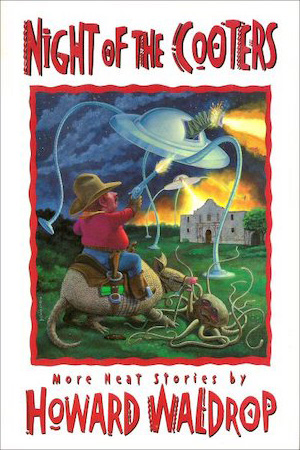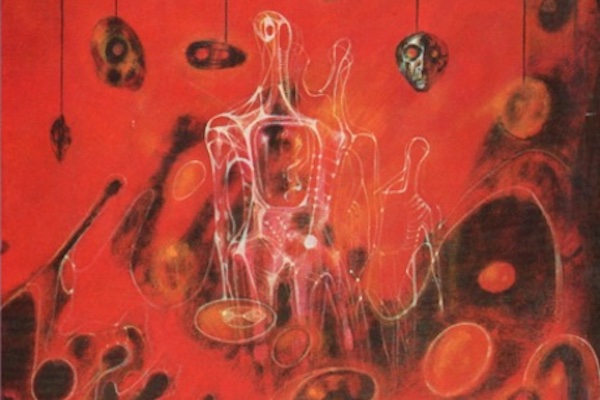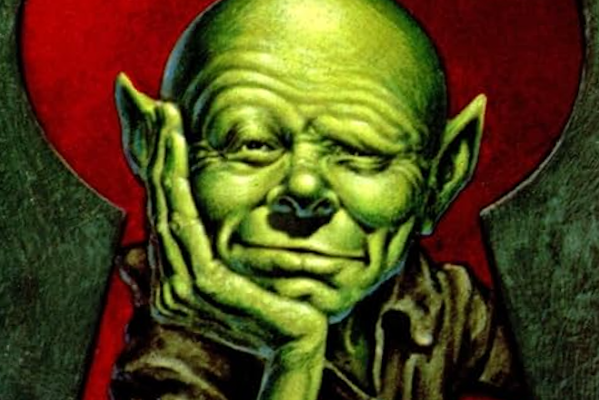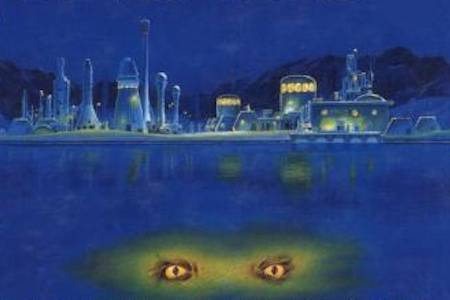In this bi-weekly series reviewing classic science fiction and fantasy books, Alan Brown looks at the front lines and frontiers of the field; books about soldiers and spacers, scientists and engineers, explorers and adventurers. Stories full of what Shakespeare used to refer to as “alarums and excursions”: battles, chases, clashes, and the stuff of excitement.
The recent passing of Howard Waldrop has brought renewed attention to his work, which although it has long been respected, has not always received the attention I think it deserves (a fact I suspect had something to do with his preference for shorter works rather than novels). I recently read one of his later collections, Night of the Cooters, and enjoyed it immensely. There is truly something for everyone in this collection. Waldrop loved to reshape old stories and themes, whether they be drawn from history, myth, movies, music, fiction or even pulp adventures, and make them uniquely his own.
A few weeks ago, I was rooting around in my basement, on the hunt for books to review. Because I had recently heard the news of his death, a collection by Howard Waldrop, Night of the Cooters, suddenly caught my eye. It was a beautifully bound and illustrated book from Ken Keller’s Ursus Imprints, published in conjunction with Mark V. Ziesing, and signed by the author. As my brother had been a friend of Mark’s from when he ran a bookstore in Willimantic, CT, and sometimes gave Ziesing books as gifts, I thought he must have given it to me; but when I opened the book, I realized that I had never read it. At that point I realized how it had probably come into my possession: I’m pretty sure it was one of my father’s books, from the collection that my brothers and I had divided between us after his passing. I had brought home boxes of books from my father, so many that I haven’t had time to read them all, and this was one of those that went overlooked in the intervening years. So it turns out I had in my possession a treasure—not only something passed down in my family, but a collection of Howard Waldrop stories that were new to me.
About the Author
Howard Waldrop (1946-2024) was an American writer of fantasy, science fiction, and alternate history, whose output primarily consisted of shorter works. You can read his Reactor obituary here. He lived most of his life in Texas, and his career spanned the years from 1977 to 2023. He was nominated for a number of Nebula and Hugo awards, and garnered a Nebula for his story “The Ugly Chickens.” Waldrop also received a World Fantasy Award for Lifetime Achievement. I reviewed another of his short story collections, Strange Monsters of the Recent Past, here.
Good Stories and Good Writing
There are some people who assume that good writing must be paired with weighty and serious topics. Fortunately for readers, that philosophy was never adopted by Howard Waldrop. He was always noted for his command of the language, not because it was polished and skillful, but because of how effectively he used it to serve the stories he was telling. Moreover, he was remarkably eclectic in the topics and subject matter of his stories. They ranged from speculation on the alternate paths history might have followed, to slapstick situations, to ancient myth, and sometimes to the lurid adventures of comic book heroes. In addition to the care and attention he gave to his writing, Waldrop possessed wide-ranging knowledge on a number of subjects and was meticulous in his research, no matter how frivolous the story might seem. In the collection I’m reviewing today, I can see this attention not only to the various fictional works he touches upon, but to the particulars of WWII aviation, ancient mythology and literature, figures drawn from history, and even the history of bicycles.
Waldrop had the ability to take a trope that might have been done to death, or even a literary cliché, and not only make it his own, but make that trope feel new and different. In his hands, the type of stories beloved by many science fiction fans suddenly felt fresh and vital—and garnered respect from beyond the science fiction community, as well. While many writers are drawn to longer formats, and particularly the novel, as the best way to make their point and convince readers to empathize with the characters, Waldrop could write a short story that got directly to the heart of the matter with wonderful efficiency. There are plenty of good writers still among us, but there will never be another Howard Waldrop.
Night of the Cooters
The book begins with an affectionate introduction by Waldrop’s friend and fellow science fiction author Chad Oliver. I should note that it takes some of the same type of surrealistic turns that you find in Waldrop’s stories, so I cannot vouch for the accuracy of the information it contains.
The first story in the collection, “Night of the Cooters,” is rooted in American Western films, but Waldrop wraps the Martian invasion from H.G. Wells’ War of the Worlds into the tale for an entertaining cross-genre mash-up. Many folks of my generation spent Saturday afternoons watching old movies on TV, so a story that draws on those tropes and characters is basically right in my wheelhouse. In his introduction, Waldrop explicitly states that the main character is based on actor Slim Pickens, which means that every time the character speaks, I hear that distinctive reedy, slightly exasperated voice in my head. The result is an entertaining romp where Waldrop’s affection for his adopted state of Texas shines through, and the slapdash response of the locals turns out to be a lot more effective than the human defenses in other locations. No need to be protected by bacteria and viruses when you have good old Texas know-how to draw on, no siree Bob!
The next story, “French Scenes,” didn’t connect as well with me; Waldrop draws on the world of art films for this tale, and not only am I not a fan of those films, but the only foreign language films I have watched with interest had rampaging kaiju in them. He adds into the story the science fictional premise of computer technology that allows a filmmaker to produce a film almost entirely single-handedly, using electronic manipulation of images drawn from the past. That premise was futuristic when the story was written in the 1980s, but almost feels possible today. The solo nature of the technology, though, also allows a director to descend into obsession, and a creative state not far from madness.
“The Passing of the Western” is an odd tale about the taming of the American continent, but offers an alternate version of events where learning to control the weather turns the arid land into the breadbasket of the world. But the story isn’t just about the adventures of the weather scientists, it’s about movies based on their adventures—furthermore, it’s not just about those movies, but is written in a quasi-epistolary style in the form of critical articles in movie magazines. As Waldrop points out in his introduction, epistolary tales have long been out of style (with occasional exceptions), and the form of this story drove his friend George R. R. Martin to distraction. But for me, the style worked very well, and made this quirky alternate history feel very real, despite its strangeness.
Speaking of older literary devices, one technique that was once extremely popular is the telling a story from the perspective of a fictional author. The next story in this collection, “The Adventures of the Grinder’s Whistle,” was written for an anthology of such stories. I initially didn’t pay too much attention to the title or fictional author when I started reading, but with the first mention of Professor Challenger, I looked back, and saw that the fictional author was Edward Malone—the narrator of the adventures of Arthur Conan Doyle’s Professor Challenger, some of my favorite stories of all time (you can find my reviews of those tales here and here).
Waldrop puts young Ned into a tale featuring another of Doyle’s fictional creations, Sherlock Holmes. The revelation that Malone could have been one of the Baker Street Irregulars triggered a palpable feeling of joy in me, what I believe youngsters these days refer to as a “nerdgasm.” The story hints at the involvement of Jack the Ripper in the death of a young woman, but then veers into a whole different direction…
Some context for the next story: Many readers will be aware George R. R. Martin, in addition to writing the Game of Thrones books, is also the creator of one of the longest running shared-world endeavors in science fiction, the world of the Wild Cards (now up to over 30 volumes strong), in which an alien virus, introduced to the world just after World War II, creates a world where superpowered heroes and villains become commonplace. Martin asked his old friend Howard Waldrop to write the first tale in the series, and the result is “Thirty Minutes Over Broadway.”
Waldrop drew on his love of comic books, and specifically the WWII-era hero Airboy, to create a similar character, Jetboy. Where Airboy was a bit more fanciful and had a bird-like aircraft, Jetboy’s plane is more rooted in reality, an early experimental jet that he uses to fight the Nazis. The Ursus hardcover edition contains blueprints in the endpapers that show the dimensions and capabilities of the jet, which somewhat resembles the real-world German Arado Ar 234 bomber that appeared late in WWII. Jetboy is portrayed as a real-world figure whose exploits have inspired more fanciful adventures in the comic books, and the juxtaposition of his real life with the portrayal in the comics gives the story some emotional depth. There are some jarringly unrelated scenes in the story that set up stories further on in the Wild Card series, but this story was still one of my favorites in the collection. Waldrop also includes “The Annotated Jetboy,” a collection of footnotes that show the research he did in preparing the story.
“Hoover’s Men” is an odd little short story that puts Herbert Hoover in charge of a new radio agency that also spurs the early development of television, and ends with a suggestion that Hitler’s career might have unfolded differently if he could have drawn on the visual power of that new media.
“Do Ya, Do Ya, Wanna Dance” is a story that feels autobiographical, and only barely science fictional. It follows a member of the Class of 1969 in the days leading up to his 20th high school reunion, and contrasts the decades of the 1960s and 1980s with a mix of nostalgia and angst. The protagonist is not entirely happy with his life, and the event triggers some strong emotions. When a local band that once had a short professional career plays at the reunion, however, their playing evokes a scene of wild abandon that segues into surrealism. The story is powerful, moving, and enigmatic, and I’m sure the emotional reactions to its ending will vary from reader to reader.
The main character of “Wild, Wild Horses” is an actual person from history, the 4th-century writer Vegetius, whose writings have survived, but about whose life almost nothing is known. The story has one of the last surviving creatures from the age of myth, a centaur named Chiron, who bribes Vegetius with long-lost manuscripts that he needs for his research, asking in return to be returned to his home. That home turns out to be a far-away land that exists on the other side of the wide ocean that stretches beyond the Pillars of Hercules. Their travels across the lands of the Mediterranean, how they hide Chiron’s true nature, and their journey across what we now know as the Atlantic Ocean all make for a compelling adventure.
The final story of the volume, “Fin de Cyclé,” was original to this collection. It is set in turn-of-the-century France (the turn of the last century, that is, from the 1800s into the 1900s). It is an alternate history that centers on the Dreyfus Affair, in which a Jewish army officer was falsely accused of passing military secrets to the Germans, resulting in his conviction and ultimately in a scandal that exposed the deep anti-Semitism that existed within French culture at that time. Waldrop also exaggerates the obsession with bicycles that led to the 1890s being referred to as Golden Age of Bicycles, and even includes a scene where bicycle-based human-powered aircraft take flight. His characters have passionate arguments on the merits of the “ordinary” bicycles, with their large front wheels, and the more compact “safety” bicycles that resemble those in common use today.
The story is chock-full of real-world characters like the novelist Marcel Proust, post-impressionist painter Henri Rousseau, writer Alfred Jarry, and film director Georges Méliès, who band together to use the new media of film to defend and support Captain Dreyfus. Furthermore, the story brings to life a fictional character from the work of Proust, Norpois, who engages Jarry in a wildly improbable duel on the Eiffel Tower, where they are required to shoot only while mounted on their bicycles. By the end, I was having trouble separating truth from fiction, swept up in the almost-real world Waldrop had created.
Final Thoughts
Night of the Cooters is a wide-ranging collection with all sorts of stories, linked only by their high quality. The book was yet another reminder for me of just how good Howard Waldrop’s writing has always been. If you’ve never experienced his work, I’d strongly encourage you to seek it out. You won’t be disappointed. And if you’d like to comment on this collection, or his other work, I look forward to hearing from you.















Definitely got me looking up publication dates with “Fin de Cycle”, since I remember reading it in Asimov’s, and the Ace edition of Night of the Cooters came out afterwards. But not the Ursus Imprints! Thanks for the surprise (yet another) from an author who loved to embed surprises in his stories.
Eugene R. I believe the publication order for Fin de Cycle was Ursus limited edition, then Asimov’s, then Ace paperback. Normally, the magazines won’t print a story that already appeared elsewhere, but a story like this cries out to be an exception to the rule.
Oh, I didn’t realize that was who had written “Fin de Cycle”. That was quite memorable when I read it in Asimov’s. Looks like this collection is a little difficult to find though as it’s out of print. Perhaps Interlibrary Loan can get it. (Charmingly, the captcha just now involved identifying bicycles).
I’m sorry that he didn’t write more novels. Them Bones was pretty good.
There are so many great stories by Howard Waldrop — and they’re so different that they don’t have to be read one by one, like those of some other … individual … authors. (E.g., reading Strahan’s The Best of R. A. Lafferty was a slow process because most of the stories were the same kind of weird.) I’m especially fond of “Ike at the Mike” (another alternate history), “Man-Mountain Gentian” (psionic sumo?!?) and “Save a Place in the Lifeboat for Me” (lightly-identified people from all over the US gather to try to prevent a disaster — it’s technically not alternate history, but knowing real history helps).